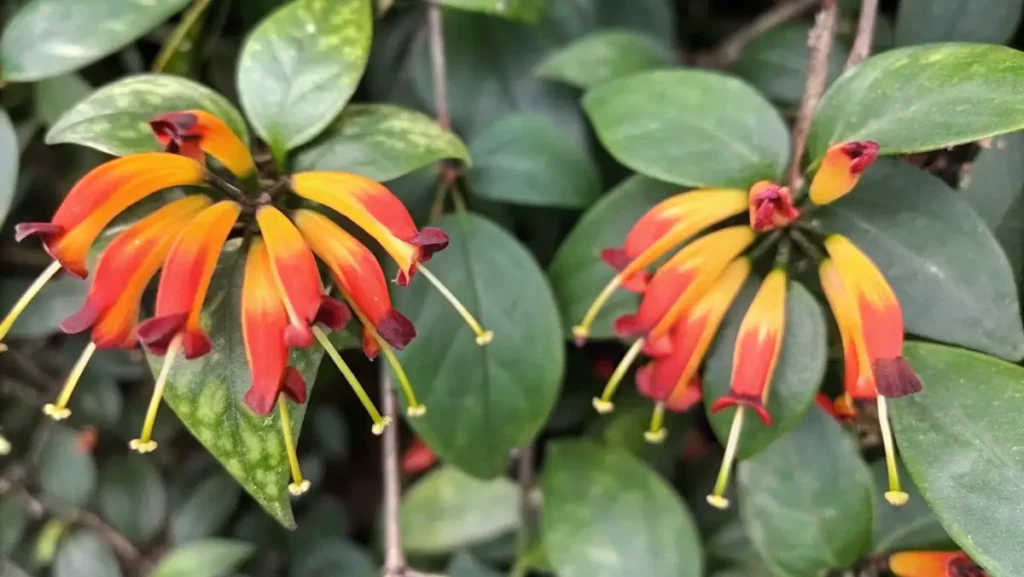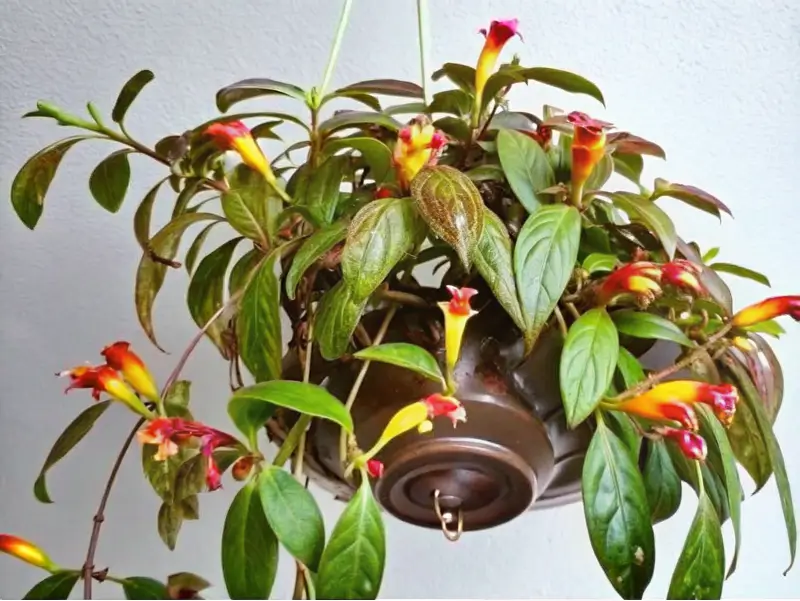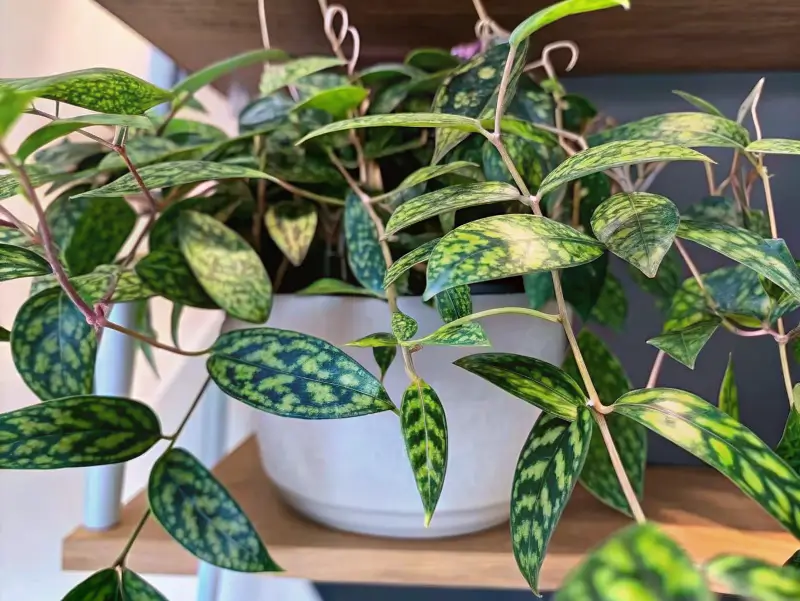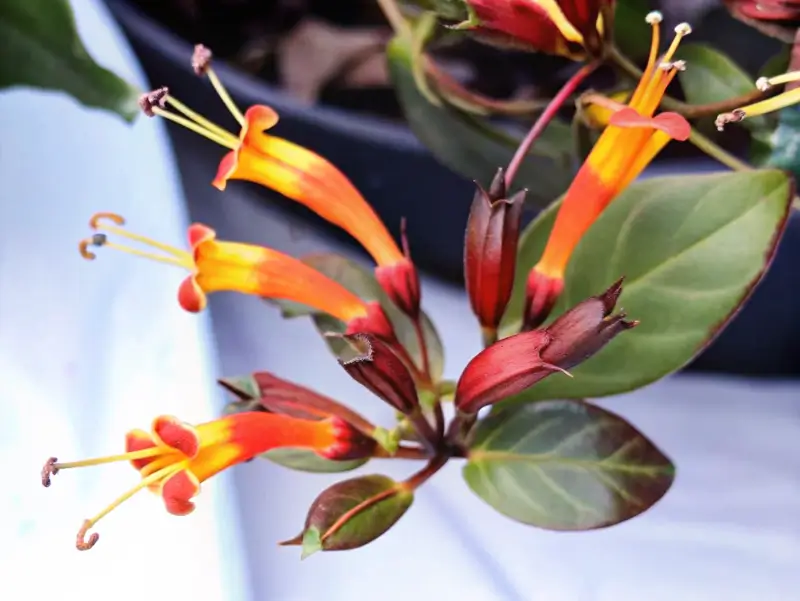
Excited to share how the black pagoda lipstick plant can transform your home with its patterned leaves and vivid blooms. I’ll cover my personal care routine, highlight its versatility in different indoor setups, and explain why it’s a top pick for those seeking unique greenery. Let’s dive in and see why this “lipstick” look creates so much buzz among plant lovers. First spotted it online—it hooked me instantly!
Table of Contents
Introduction to the black pagoda lipstick plant
A Unique Houseplant with Major Personality
I’ve always adored indoor plants, but the black pagoda lipstick plant quickly climbed the ranks in my home. Officially, it’s sometimes called Aeschynanthus longicaulis, but many folks refer to it simply as the “lipstick vine.” Its blossoms look like tiny lipsticks poking out of the foliage—total conversation starter.
The leaves are surprisingly thick and semi-succulent, often with a marbled top and dark underside. In my space, it adds a tropical vibe that fits in perfectly with other trailing houseplants. I’m telling you, those swirling vines just bring life to a dull corner.
- Why you’ll love it:
- Intriguing leaf patterns
- Tube-shaped lipstick blooms
- Tropical flair
Because it’s an epiphytic vine, it likes well-draining soil and moderate watering. I’ve found it’s much simpler to care for than it looks—no need to feel intimidated. Keep the environment warm with decent humidity, and you’ll see it flourish.
Lipstick Plant Obsession
Let’s be real. Everyone’s into monsteras or fiddles, but the lipstick plant black pagoda demands attention. Whenever a new bloom appears, I feel like I’ve hit the jackpot. It’s that exciting, trust me!
Distinguishing Features and Varieties
Lipstick Plant Varieties to Check Out
There’s a wide range of lipstick plants out there. Some have solid green leaves, while others show intricate variegation. Aeschynanthus radicans is another popular one, but the lipstick black pagoda plant stands out thanks to its eye-catching markings and bold flowers.
- Common Varieties:
- Mona Lisa Lipstick Plant (known for red flowers)
- Aeschynanthus radicans (classic lipstick vine)
- Black pagoda lipstick plant (marbled leaves, deep purple underside)
Each variety’s leaves can differ in size and pattern. I personally love the distinct streaking on the “black pagoda” type. It just screams “look at me,” even on a cloudy day.
Why the black pagoda lipstick plant Shines
Let me tell you—every time friends drop by, the first thing they point out are those unique leaves. They’re thick, almost leathery, and sport a mix of dark greens, creams, and purples. Plus, the underside can be extra dramatic, showing deep reds or purples when light hits it from behind.
- Key standouts:
- Semi-succulent leaves
- Tubular blooms reminiscent of small lipsticks
- Trailing growth perfect for hanging baskets or shelves
Because it has such thick leaves, it can hold water reserves better than many other tropical plants. So if you forget a watering here or there, it’s fairly forgiving. Honestly, for me, that’s a big plus (I can get lazy!).
Ideal Growing Conditions for black pagoda lipstick plant

Light Requirements: Do Lipstick Plants Like Sun or Shade?
If there’s one question that hovers around these plants, it’s lighting. The black pagoda lipstick plant appreciates bright, indirect sunlight. You can stick it near an east-facing window so it catches gentle morning rays but avoids intense midday light. If your only option is a south-facing window, just pull it back a bit or use a sheer curtain. Too much sun might scorch those fancy leaves.
- Yes: Bright, filtered light
- No: Harsh direct sun
However, can it manage in lower light? Kinda. But you’ll probably see fewer blooms and less intense leaf coloration.
Soil Composition and Watering Essentials
I always treat my black pagoda lipstick plant somewhat like a succulent. It wants a well-draining potting mix, perhaps one with perlite or orchid bark.
- Soil Must-Haves:
- Good drainage
- Lightweight components like bark or perlite
- pH around neutral
When it comes to watering, I rely on the “finger test.” If the top inch is dry, it’s time to water. I pour slowly until water drains from the bottom, then let it rest. Overwatering is a big no-no because it leads to common issues like root rot. Let’s face it: root rot is the devil. Consistency, combined with the right soil, keeps the roots healthy and the blooms coming.
Propagation and Plant Care Guidelines
Effective Propagation Methods for the black pagoda lipstick plant
I love propagation—who doesn’t want free new plants? For the black pagoda lipstick plant care, I usually snip about 4-inch stem cuttings with a few leaves still attached. Removing the lower leaves prevents rot when you place the stem in water.
- Propagation Steps:
- Cut a healthy stem below a node
- Remove lower leaves
- Place in water or well-draining soil
- Wait for roots to appear
You can even apply a rooting hormone if you’re feeling fancy, but it’s typically not necessary. Water propagation often works best for me because I can see the roots forming. Once they reach about an inch long, I gently move them to a potting mix. Keep the environment humid—maybe put a plastic bag on top with tiny holes for airflow. This helps the cuttings adjust.
Routine Maintenance Tips
Maintaining a thriving lipstick plant black pagoda involves:
- Regular Inspection:
- Check for pests like mealybugs or spider mites
- Remove any yellowing or dead leaves
- Fertilizer Schedule:
- Use a balanced fertilizer at half strength
- Fertilize monthly in spring and summer
- Skip or reduce feeding in colder months
- Pruning:
- Trim leggy vines to encourage bushier growth
- Prune after blooms fade
Honestly, if you keep these main points in mind, you’ll find that the black pagoda lipstick plant flower keeps appearing. Any time I see tiny buds forming, I do a happy dance. This plant’s show-stopping tubular flowers never cease to amaze me.
By the way, if you need even more in-depth tips on Lipstick Plant care, check out this helpful resource on the Lipstick Plant. My day-to-day routine is pretty similar to what they recommend.
And if you’re building a broader indoor jungle, you might also enjoy reading about Philodendron melanochrysum. It pairs beautifully with trailing vines if you want an indoor mini-rainforest vibe.
Common Problems with black pagoda lipstick plant and Troubleshooting
Identifying Pests, Diseases, and Other Issues
Let’s talk about the worries. Even a robust plant can attract unwanted guests. Mealybugs love to hide in leaf joints, creating cotton-like spots. Spider mites sometimes appear, especially if humidity is low. If you spot these microscopic troublemakers, move fast. I dab rubbing alcohol on affected spots or gently wash the leaves with a mild soapy solution.
- Potential Problems:
- Mealybugs: White, cottony lumps
- Spider mites: Tiny webbing under leaves
- Overwatering: Yellowing, droopy leaves
Root rot creeps in if you keep soil soggy. I learned that the hard way when I first started. My poor plant had mushy stems, and I had to cut away any brown roots to save it.
Proven Solutions and Preventative Measures
- Solutions:
- Quarantine infested plants
- Treat with mild insecticidal soap or rubbing alcohol
- Let topsoil dry between waterings
- Prevention:
- Keep humidity stable
- Use proper watering intervals
- Prune damaged leaves promptly
Remember, a healthy environment is your best defense. Good light, fresh air, and spacing plants so they’re not cramped can all help.
Beautiful Ways to Display Your Lipstick Plant

Hanging Baskets and Creative Indoor Arrangements
I find the easiest way to show off the black pagoda lipstick plant flower is by hanging it. When the vines trail down, it looks like botanical curtains swaying in whatever breeze sneaks in.
- Styling Tips:
- Hang near a well-lit window
- Use a sturdy macramé hanger for a boho flair
- Pair with other trailing houseplants like pothos or string of pearls
Using Terrariums and Other Decorative Ideas
Sometimes, I’ll place it in a large glass vessel for added humidity. But I keep the top open so air can circulate. For extra flair, add decorative pebbles or even small figurines (I’m a big fan of tiny dinosaur statues!). By the way, this plant also looks brilliant on a bookshelf, letting the vines dangle over the edges. If you pair it with Philodendron melanochrysum, you’ll have a tidy, exotic arrangement that begs attention.
black pagoda lipstick plant vs. Hoya: Key Differences
Similarities in Appearance and Care
People often ask if the black pagoda lipstick plant is related to hoyas. While both have thick, fleshy leaves and appreciate bright, indirect light, they come from different plant families. I do adore hoyas (especially the heart-shaped Hoya kerrii), so I see the appeal. However, once you see the tube-shaped black pagoda lipstick plant flower, you can’t confuse it for a hoya’s star-shaped clusters.
- Both Plants:
- Enjoy well-draining mixes
- Thrive in moderate to high humidity
- Benefit from steady watering cycles
Unique Traits That Differentiate Lipstick Plants from Hoyas
Hoyas typically cling to trellises or climb upward, whereas the lipstick vine tends to cascade gracefully. The leaves on the lipstick vine often show striking patterns. Hoyas may have interesting veins or shapes, but they rarely match the marbled underside you see on the lipstick black pagoda plant.
- Distinct Qualities:
- Hoya flowers: Clustered, waxy stars
- Lipstick flowers: Tubular, bright “lipstick tip”
- Leaves differ in variegation and thickness
So, is a black pagoda lipstick plant a hoya? Definitely not. They share certain care aspects but remain unique plants for your collection.
Tips for Seasonal Maintenance
Adjusting Watering and Feeding Methods Year-Round
Our seasons can shift like crazy, right? In spring and summer, the black pagoda lipstick plant care routine involves slightly more frequent watering because the plant grows faster. By fall, I cut back a little, and in winter, I’m incredibly cautious about overwatering. The shorter days usually mean slower growth, so the soil stays wet longer.
- Seasonal Water Routine:
- Spring/Summer: Water when topsoil is dry
- Fall: Start spacing out watering
- Winter: Water sparingly every few weeks
For feeding, I use a balanced fertilizer at half strength every month or so in the warmer months. Once temps drop, I ease off on fertilizing. Overfeeding in cooler conditions can lead to weird growth or leaf burn.
Preparing for Temperature and Humidity Changes
I keep a small humidifier running in the drier months. Since the black pagoda lipstick plant loves humidity, I try to maintain a cozy environment. If a humidifier isn’t an option, placing the pot on a tray of pebbles with water also helps keep moisture around it. Watch out for drafty doors or windows in winter! Sudden temperature changes can cause the plant to drop buds or leaves.
Significance of This Ornamental Houseplant in Interior Décor

Enhancing Aesthetic Appeal with Intriguing Foliage
With its marbled leaves and rich purple underside, the black pagoda lipstick plant basically doubles as living art. It matches both modern and eclectic decor. I once placed mine next to sleek black furniture and found that it popped brilliantly. The contrast made the intricate leaf veins shine.
- Indoor Decor Benefits:
- Adds a lively, tropical look
- Complements a range of styles
- Acts as a living conversation piece
Bringing a Touch of the Tropics Indoors
If you’re craving a little slice of the tropics, this plant does the trick. While I’ve traveled to humid jungles before, it’s not something I can do whenever I want. So having my own black pagoda lipstick plant indoors scratches that itch.
- Atmosphere Boosters:
- Warm lighting plus a pop of greenery
- Grouping with other tropicals
- Maintaining consistent humidity
Even if you’re living in a big city with no direct access to lush rainforests, your lipstick black pagoda plant can give you that mini-getaway feeling right at home.
FAQs about the black pagoda lipstick plant
How do you care for a black pagoda lipstick plant?
Caring for the black pagoda lipstick plant is straightforward. It loves bright, indirect light and appreciates watering only when the topsoil dries. Use a light, well-draining mix. Keep humidity levels steady and watch for pests. Pruning spent blossoms and leggy vines every so often helps it stay vibrant.
Do lipstick plants like sun or shade?
They do best in bright, indirect sun. Direct rays—especially at midday—could scorch the leaves. Partial shade might work, but you’ll probably get fewer blooms.
Where is the best place to put a lipstick plant?
I keep mine in a hanging basket near an east-facing window that catches gentle morning light. It’s protected from the harsh midday sun while still basking in bright conditions. Just avoid drafty spots or extremely low light areas.
Is a black pagoda lipstick plant a hoya?
Nope! Hoyas and lipstick plants share certain care preferences but differ in botanical family, flower shape, and leaf variegation. The lipstick plant black pagoda has tubular blooms, while hoyas typically produce star-shaped clusters. Similar vibe, different plant.
Additional Thoughts & Helpful Resources
Whenever I’m unsure about standard plant guidelines, I peek at reputable government sites such as the USDA. It’s filled with general agricultural pointers that can be handy for plant enthusiasts, too.
- Quick Reminders:
- Water sparingly in winter to avoid root rot
- Give your plant moderate, filtered sun
- Prune after flowering to shape the vine
- Watch for mealybugs or spider mites
By the way, if you’re also jazzed about building a bigger houseplant collection, consider adding a Philodendron melanochrysum. Its large, velvety leaves create a striking contrast next to the marbled leaves of your black pagoda lipstick plant.

1 thought on “How to Grow and Care for Black Pagoda Lipstick Plant”
Comments are closed.